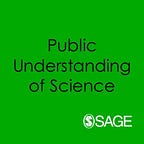BOOK REVIEW
Idea Colliders — the future of science museums
Review by Louise Whiteley
Idea Colliders is a rich example of a creative, critical reaction to what the Science Gallery team saw as lacking in the contemporary science landscape
Idea Colliders tells the story of Science Gallery, a game-changing experiment in public engagement established at Trinity College Dublin in 2009. Michael John Gorman was its founding director, who persuaded the university to abandon their original plans for a “shop window” celebrating recent scientific discoveries and, instead, to open a space hosting cross-disciplinary exhibitions and events. These have been based on big themes such as Infectious, Plastic, or Seeing, populated via open calls and staffed by student mediators who engage visitors in conversation rather than delivering tours and demonstrations.
Science Gallery was built on a wish-list of desires that will be familiar to readers of this journal, from opening up the processes of science, to exploring the fertile ground between art, design, science, and innovation; from embodying a sociological vision of science in context, to bringing public perspectives into the development of research itself.
In Idea Colliders, the thread that ties these laudable goals together is the idea of science museums and centres as “connectors and brokers, as providers of bridging social capital, rather than transmitters of cultural capital”. Borrowing from Robert Putnam’s digestion of Bourdieu’s ideas, ‘bridging social capital’ involves creating connections between dissimilar kinds of people, along which other forms of capital can flow.
The book contains eight diverse chapters, making up a collage of perspectives on Science Gallery. We learn about the history of the project and its origins in Gorman’s personal story; we read about practical and organisational matters and the theories behind them; and we are invited to understand Science Gallery as part of the history of science museums and alternative cultural engagements with science.
The book bubbles with concrete examples and quotes from figures as diverse as the cellist YoYo Ma and Galileo Galilei. It shifts sometimes dizzyingly from personal anecdote to academic survey or pragmatic report. At times this felt messy, greedy almost, but the breezy yet serious style carried me along — this is the good kind of collage, a prism that expands vision. The collage form also echoes Science Gallery’s model of open call curation — it reads almost like an ‘open call’ into Gorman’s mind and memory.
I have found Gorman’s ideas inspiring in my own work at Medical Museion in Copenhagen. One key difference between the two institutions is that, as a museum, we hold a continuously updated collection of material objects and treat history as a central player in our particular collage of science, art and culture. Whilst Idea Colliders is subtitled The Future of Science Museums, it sometimes feels like museums are rather superfluous.
Towards the end of the book, Gorman recounts that the success of the mediators led them to wonder if they really needed exhibits at all — are museums then just useful, big, spaces with inherited cultural and social capital for “connective social tissue” to piggyback upon? Idea Colliders uses history to great effect and is full of examples of how particular material things prompted the conversations that are its ultimate goal. I would have appreciated a more thorough consideration of the role of the material, and how this inflects sociological theory. I am also curious about whether this might draw attention to the spaces and silences that surround conversation and connection.
Metaphors of ecosystems and evolutionary niches are increasingly popular in science communication, resonating with a wider cultural emphasis on the complex, interconnected systems we all live in.
Idea Colliders is a rich example of this but blends its metaphorical ecosystems and new life forms with connective tissues, membranes, rhizomes, strange bedfellows and filter bubbles. Picking fewer metaphors would have made the argument more precise, but I also appreciated the cumulative effect of so many different ways of saying that we, and our institutions, are hopelessly dependent on each other.
I am less keen on the titular ‘colliders’, which comes from the Science Gallery’s tagline “where science and art collide”. Whilst collision borrows some lively resonance from the imaginative leaps of particle physics, to me it feels a little too violent, too muscular for the bridging conversations and collaborations that Science Gallery facilitates.
There is also a ‘Windows’ chapter awkwardly sitting in the middle of the book, structured around ten dichotomies between old and new cultural institutions, expressed by a series of mystifying icons. Whilst treated with nuance, dichotomies seem like a rather strange choice for a book so interested in ‘edge spaces’ where diverse new forms arise.
Science museums and centres have always responded to what they saw as lacking in other societal institutions — whether providing hands-on education that schools could not, or encouraging innovation to flourish outside profit motives. This response inevitably shifts over time, and Idea Colliders is a rich example of a creative, critical reaction to what the Science Gallery team saw as lacking in the contemporary science landscape. It will be interesting to see how the new members of the growing international Science Gallery network respond to their own local contexts. Idea Colliders is a great read and full of inspiration — a catalogue of cool ideas, with snappy phrases to help persuade our institutional masters of the need for brave funding that looks beyond immediately measurable impact.
Louise Whiteley is an Associate Professor of Medical Science Communication at Medical Museion and the Novo Nordisk Foundation Center for Basic Metabolic Research, University of Copenhagen, Denmark. She also curates exhibitions and events, including Mind the Gut.
Her research interests include how biomedical research affects and reflects how we see ourselves, cultural representations of the microbiome, and how making things together can facilitate public engagement and interdisciplinary research.
